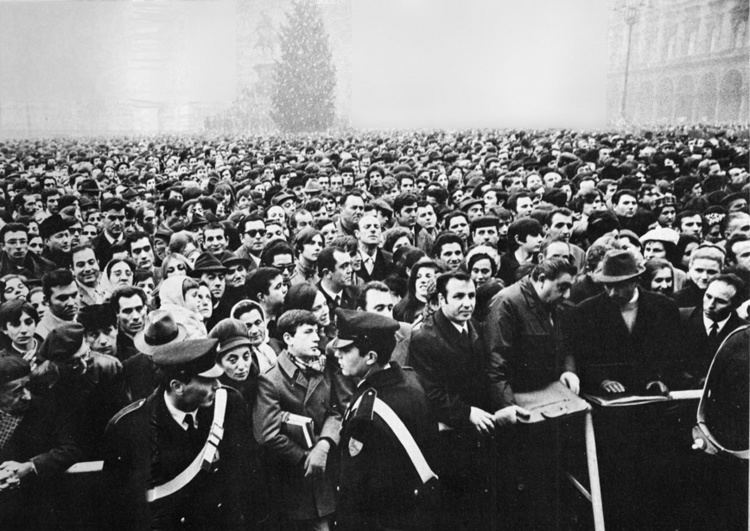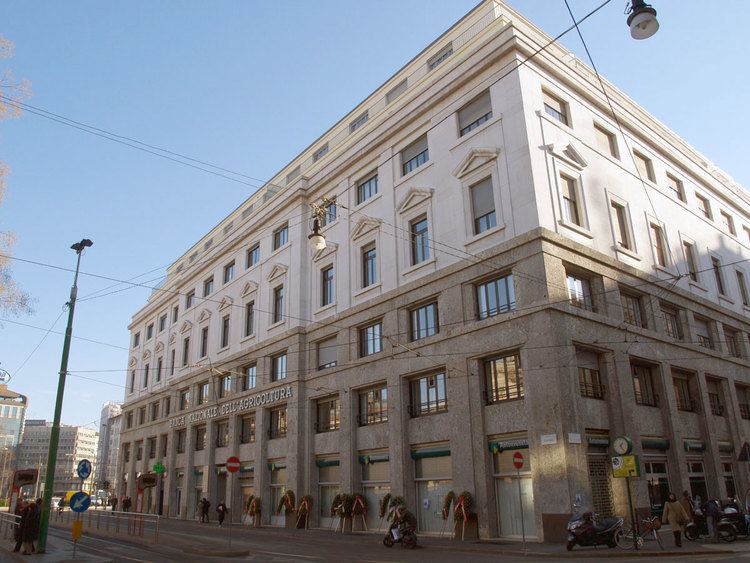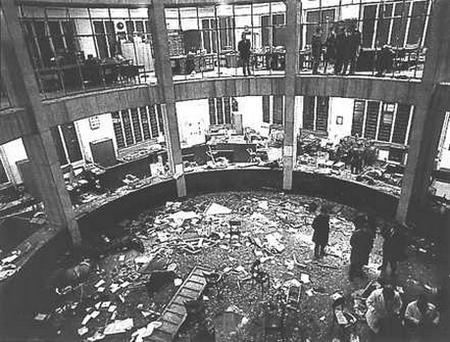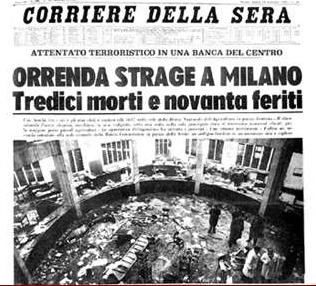Weapons Bomb Start date December 12, 1969 Total number of deaths 17 | Non-fatal injuries 88 Perpetrator Carlo Digilio Non fatal injuries 88 | |
 | ||
Target Banca Nazionale dell'Agricoltura Similar Piazza della Loggia b, Bologna massacre, Italicus Express Bombing, Aerolinee Itavia Flight 870, Train 904 bombing | ||
The Piazza Fontana Bombing (Italian: Strage di Piazza Fontana) was a terrorist attack that occurred on 12 December 1969 when a bomb exploded at the headquarters of Banca Nazionale dell'Agricoltura (National Agrarian Bank) in Piazza Fontana (some 200 metres from the Duomo) in Milan, Italy, killing 17 people and wounding 88. The same afternoon, three more bombs were detonated in Rome and Milan, and another was found unexploded.
Contents
Piazza Fontana

On 25 April 1969 a bomb exploded at the Fiat booth at a Milan trade fair, in which five people were injured. There was also a bomb discovered at the city's central station. The explosion at Piazza Fortuno was not the first, but part of a well-coordinated series of attacks.
Deaths of Pinelli and Calabresi

The Piazza Fontana bombing was initially attributed to anarchists. After over 80 arrests were made, suspect Giuseppe Pinelli, an anarchist railway worker, died after falling from the fourth floor window of the police station where he was being held. Serious discrepancies existed in the police account, which initially maintained that Pinelli had committed suicide by leaping from the window during a routine interrogation session. Three police officers interrogating Pinelli, including Commissioner Luigi Calabresi, were put under investigation in 1971 for his death, but a later inquiry filed October 25, 1975 concluded that there were no wrongdoings regarding Pinelli's death: public prosecutor Gerardo D'Ambrosio established that his fall had been caused by fainting and losing balance.

Despite being exonerated, the far-left organisation Lotta Continua held Calabresi of being responsible for the death of Pinelli, and in 1972 he was murdered by left-wing militants in revenge. Adriano Sofri and Giorgio Pietrostefani, former leaders of Lotta Continua, were convicted of plotting Calabresi's assassination, while members Ovidio Bompressi and Leonardo Marino were sentenced for carrying it out.
Official investigations and trials

Anarchist Pietro Valpreda was also arrested after a taxi driver, called Cornelio Rolandi, identified him as the suspicious-looking client he had taken to the bank that day. After his alibi was judged insufficient, he was held for three years in preventive detention before being sentenced for the crime. In 1987 he was acquitted by the supreme Court of Cassation for lack of evidence.
The far-right Neo-fascist organization Ordine Nuovo, founded by Pino Rauti, came under suspicion. On 3 March 1972 Franco Freda, Giovanni Ventura and Rauti were arrested and charged with planning the terrorist attacks of 25 April 1969 at the Trade Fair and Railway Station in Milan, and the August 8 and August 9, 1969 bombings of several trains, followed by the Piazza Fontana bombing.
In 1987, after a number of trials, the Court of Cassation ruled that despite evidence linking Freda, Ventura, and others to the Piazza Fortana bombing, it could not be determined for certain who planned it, nor who carried it out. The Court confirmed the convictions of Freda and Ventura in relation to the bombs placed in Padua and Milan, for which they each received a sentence of 16 years.
Also in 1987 the Milanese Guido Salvini reopened the investigation based on new evidence. Martino Siciliano, a member of Ordine Nuovo, decided to cooperate when presented with a taped telephone conversation between Delfo Zorzi and some associates which contained the observation that, "the Siciliano problem could be solved with a 9 caliber gun". Siciliano said that he had been present at a meeting with Zorzi and Carlo Maria Maggi in April 1969, in the Ezzelino bookstore in Padua owned by Giovanni Ventura, when Freda announced the program of the train bombings. Despite a death threat from Pino Rauti, electrician Tullio Fabris testified that he had supplied Freda with primers and timers.
Carlo Digilio, confessed explosives expert and advisor to the Ordine Nuovo in the Veneto was convicted in June 2001, which was subsequently upheld on appeal in March 2004. Digilio displayed instances of memory loss after suffering a stroke in 1995. His subsequent confusion regarding dates and events led to the Court declaring him an unreliable witness.
In a 2004 trial of neo-fascists the Milan Court of Appeal attributed the Piazza Fontana bombing to Freda and Ventura. However, since they had been acquitted in 1987 they could not be retried.
State security service
General Gianandelio Maletti, the head of SID (Servizio Informazioni Difesa), and a member of the secret "masonic" society P2 was found responsible for obstructing the investigation and withholding information during the first trial in Catanzaro. In an effort to protect extreme right-wing groups, Maletti destroyed a report concerning the Padua cell of Ordine Nuovo and arranged for potential witnesses to leave the country. Maletti subsequently emigrated to South Africa.
Captain Antonio Labruna, of SID, was also implicated in aided and abetting the departure of witnesses Marco Pozzan and Giannettini Guido. Maletti and Labruna were convicted in January 1987.
Several elements brought the investigators to the theory that members of extreme right-wing groups were responsible for the bombings:
First trial
Main stages of the trial:
The supreme Court of Cassation sentenced two members of the Italian secret services – General Gian Adelio Maletti (1 year of jail) and Captain Antonio Labruna (10 months) – to having misled the investigation and acquitted Marshal Gaetano Tanzilli, accused of perjury.
Second trial
Third trial
Stefano Tringali, accused of abetting, benefited from the prescription after being sentenced to one year in prison in the appeal trial.
The Supreme Court rejected as «false» Digilio's «alleged affiliation with US services». The Court found that in 1969 the Venetian group of Zorzi and Maggi organized the attacks, but it is not proven their participation in the massacre of 12 December. The Court certifies that Martino Siciliano (another Ordine Nuovo's pentito) attended to the assembly with Zorzi and Maggi in April 1969, in the library Ezzelino of Padua, where Freda announced the program of the train bombings. But since those bombs didn't kill nobody, it's not evidence the involvement of Zorzi and Maggi in the next subversive strategy of Freda and Ventura, and in the other acts of terrorism. The tragic events of 12 December 1969 didn't represent a loose cannon, but were the result of a subversive operation enrolled in a program subversive well settled.
Political theories of responsibility for the bombing
The bombing was the work of a right wing group, Ordine Nuovo whose aim was to prevent the country falling into the hands of the left -wing by duping the public into believing the bombings were part of a communist insurgency.
A 2000 parliamentary report published by the Olive Tree coalition (an alliance of the Communist Party and the Democratic Party of the Left) claimed that "U.S. intelligence agents were informed in advance about several right-wing terrorist bombings, including the December 1969 Piazza Fontana bombing in Milan and the Piazza della Loggia bombing in Brescia five years later, but did nothing to alert the Italian authorities or to prevent the attacks from taking place." It also alleged that Pino Rauti (current leader of the MSI Fiamma-Tricolore party), a journalist and founder of the far-right Ordine Nuovo (New Order) subversive organization, received regular funding from a press officer at the U.S. embassy in Rome. "So even before the 'stabilising' plans that Atlantic circles had prepared for Italy became operational through the bombings, one of the leading members of the subversive right was literally in the pay of the American embassy in Rome", the report says.
Paolo Emilio Taviani, the Christian Democrat co-founder of Gladio (NATO's stay-behind anti-Communist organization in Italy), told investigators that the SID military intelligence service was about to send a senior officer from Rome to Milan to prevent the bombing, but decided to send a different officer from Padua in order to put the blame on left-wing anarchists. In an August 2000 interview with Il Secolo XIX newspaper Taviani said that he did not believe the US Central Intelligence Agency was involved in organising the Milan bomb. However he alleged "It seems to me certain, however, that agents of the CIA were among those who supplied the materials and who muddied the waters of the investigation."
